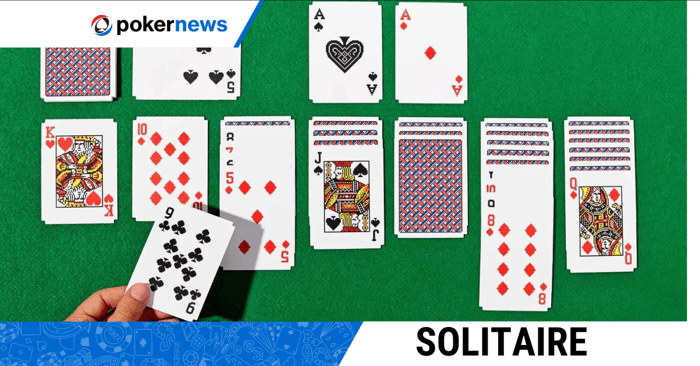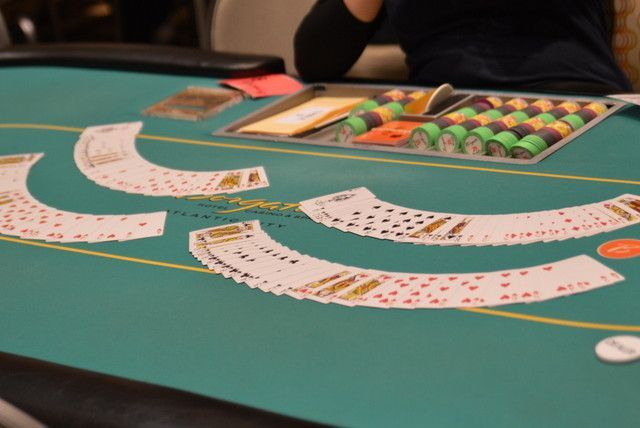How to Play Solitaire: Rules, Layout & Gameplay Explained

Solitaire is a classic card game that millions of people enjoy with a physical deck of cards, on a mobile phone app, or on their computer. To beginners, it may seem somewhat complicated to know how to start playing, but it's really not once you know a few basics. So, here is the complete guide on how to play Solitaire.

Solitaire Rules and Setup
Solitaire, also known as Patience, is a popular single-player card game with a simple setup and layout. Here's how to get started:
Solitaire Setup & Layout
Start by thoroughly shuffling a standard deck of 52 playing cards.
Then deal out seven tableau columns, each containing one card, then two cards in the second column, three in the third, and so on, up to seven cards in the last column. The top card in each column should be face-up, while the rest are face-down.
Place the remaining cards facedown in a stack, known as the draw pile. You will use the draw pile throughout the game; more on that shortly.
Create four foundation piles above the tableau columns. These will be used to build ascending sequences for each suit, starting with an ace and ending with a king.
The Objective of Solitaire
The objective of Solitaire is to successfully organize all the cards into foundation piles according to specific rules. These foundation piles must be built in ascending order, beginning with the ace and progressing through the numerical sequence to the king, for each suit—hearts, diamonds, clubs, and spades.
Meanwhile, within the tableau columns, cards are arranged in a descending order, and colors must alternate. For instance, a black 7 should be placed on a red 8, and this pattern continues as the game progresses. Adhering to these rules and strategically moving cards within the tableau ultimately leads to the successful completion of the game.
Important Notice: Traditional Card Games are popular with players of all ages, but the content on this website is intended only for adults, over the required age for gambling online in your location.
Solitaire Gameplay
Playing Solitaire involves a straightforward process outlined in five simple steps. First, turn over cards from the draw pile one at a time, and strategically move them to the tableau columns or foundation piles, adhering to the specified rules. If a tableau column becomes empty, it can be filled with any King or a King with its sequence.
Continue the game by drawing cards from the draw pile and placing them in the tableau columns or foundation piles, ensuring compliance with the established rules. Keep progressing until no more moves can be made. In such a scenario, turn over the top card from the stock (the remaining facedown cards in the draw pile) and resume playing.
Should you exhaust all possibilities with the stock cards and still find yourself unable to make any more moves, the game concludes. At this point, you can assess your progress and determine the outcome of your Solitaire endeavor.
Winning at Solitaire
You win Solitaire when you successfully build all four foundation piles, one for each suit, from ace to king. Studies show that approximately 80% of Solitaire games are winnable, meaning they have at least one path to victory. This doesn't mean you'll win 80% of the games you play, but you can try!
Solitaire is a game of patience, hence its other popular name, and careful planning. Sometimes, you may need to undo moves or try different strategies to succeed. With practice, you'll improve your abilities and enjoy the challenge of playing this engaging card game. Don't be discouraged if you don't win every time; Solitaire rewards persistence and strategic thinking.
Variations of Solitaire
Solitaire offers numerous variations that add unique twists to the classic game. For example, Spider Solitaire uses two decks and requires players to build sequences in descending order within the tableau columns.
Freecell allows more strategic moves thanks to having an open cell and four free cells, while Pyramid Solitaire involves pairing cards to clear a pyramid-shaped tableau. Pyramid Solitaire is the most challenging variant due to the sheer number of variables in play.
Klondike, the standard version, sets the foundation for many of these variations with its goal of building ascending sequences. Each variant introduces different rules and challenges, making Solitaire a versatile and engaging card game that caters to various preferences and skill levels.
How to Play Solitaire FAQs
What is the objective of Solitaire?
The primary objective of Solitaire is to arrange all 52 cards into foundation piles, with one foundation pile for each suit (Hearts, Diamonds, Clubs, and Spades). Cards should be arranged in ascending order, starting with an Ace and ending with a King.
Can I move more than one card at a time in Solitaire?
In most versions of Solitaire, you can only move one card at a time. However, there are variations that allow moving sequences of cards under certain conditions.
How do I win a game of Solitaire?
You win a game of Solitaire by successfully moving all cards to their respective foundation piles in the correct order (Ace to King) and for each suit.
What are tableau piles in Solitaire?
Tableau piles are the columns of cards in the main playing area of Solitaire. Cards in tableau piles can be moved in descending order and must alternate colors (red and black).
What should I do if I can't make any more moves in Solitaire?
If you're unable to make any more moves in Solitaire, you can draw cards from the stock to the waste pile. You can only go through the stock once. Once the stock is empty, you can move the cards from the waste pile back to the stock if needed.
How many variations of Solitaire are there?
There are numerous variations of Solitaire, with popular ones including Klondike, Spider, Freecell, and Pyramid Solitaire. Each variation has its own unique rules and objectives.
Can I play Solitaire on my computer or mobile device?
Yes, Solitaire is a popular game that's available on most computers and mobile devices. It's often included in operating systems or can be downloaded as apps.
Is there a time limit to playing Solitaire?
No, there is no time limit when playing traditional Solitaire. You can take your time to make moves and strategize without any rush.
Can I undo moves in Solitaire?
In digital versions of Solitaire, there is often an "Undo" feature that allows you to reverse your previous moves. However, in the physical card game, undoing moves may not be possible.
What are the general principles for winning at Solitaire?
To improve your chances of winning, focus on uncovering face-down cards, creating empty tableau piles to free up Kings, and moving Aces to foundation piles as early as possible.
